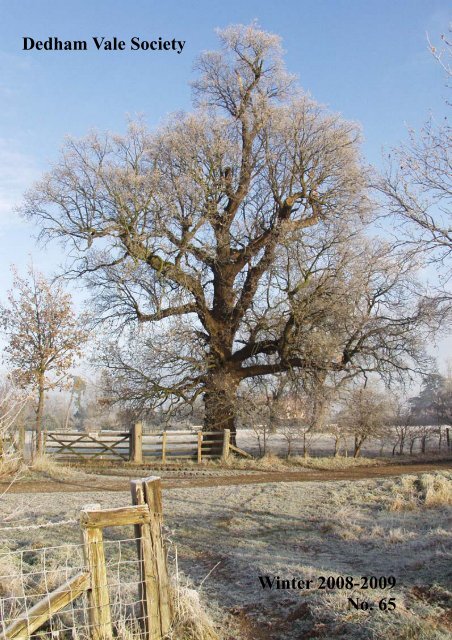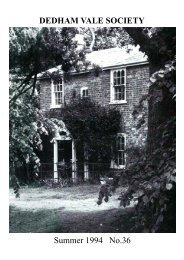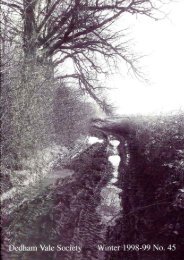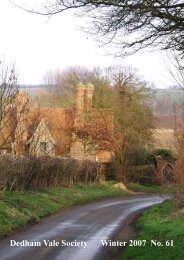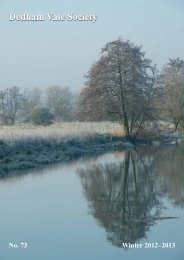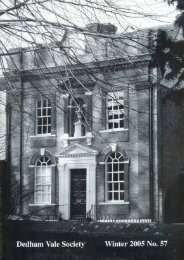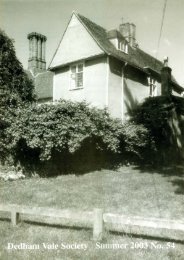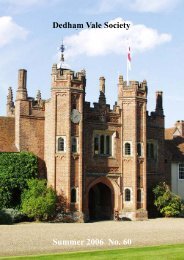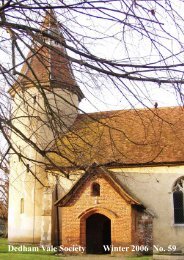Dedham Vale Society Winter 2008-2009 No 65
Winter 2009 pdf 1.4Mb - Dedham Vale Society
Winter 2009 pdf 1.4Mb - Dedham Vale Society
You also want an ePaper? Increase the reach of your titles
YUMPU automatically turns print PDFs into web optimized ePapers that Google loves.
<strong>Dedham</strong> <strong>Vale</strong> <strong>Society</strong>1<strong>Winter</strong> <strong>2008</strong>-<strong>2009</strong><strong>No</strong>. <strong>65</strong>
DEDHAM VALE SOCIETY(Founded 1938, Registered Charity <strong>No</strong> 246007)www.dedhamvalesociety.org.ukPRESIDENTRobert Erith TD DLCHAIRMANCharles CloverHONORARY SECRETARYSarah CarrGulson’s Farm, Boxted Church StreetColchester CO4 5SX01206 272207mrscarr@btinternet.comHONORARY TREASURERMichael ParkerJupes Hill House, <strong>Dedham</strong>Colchester CO7 6BJ01206 322133michaelj.parker@btinternet.comMEMBERSHIP SECRETARYJohn OsbornBailey House, Brook Street,<strong>Dedham</strong>, Essex CO7 6AD01206 322157johnfosborn@btinternet.comPLANNING OFFICER ESSEXRoger DruryWorkhouse Cottages, Workhouse Lane,Little Horkesley, COLCHESTER CO6 4DS01206 271454roger.drury@btinternet.comPLANNING OFFICER SUFFOLK AND NEWSLETTER EDITORDavid EkingFarthings, Thorington StreetStoke by NaylandCOLCHESTER CO6 4SP01206 337477david.eking@btinternet.comCOMMITTEE MEMBERSMichael ArcherQuinlan TerryAdam Sedgwick01206 32216901206 33720901206 262347Nella ProbertPaul GallifantChristopher RobinsonRosemary Turner 01206 271666 (CPREssex)01787 22809501206 39420201787 227179Front Cover<strong>Winter</strong> in the <strong>Dedham</strong> <strong>Vale</strong>, January <strong>2009</strong>(photograph by Paul Gallifant)2
EDITORIALThis edition has been prepared in some of the coldest winter weather for several years and PaulGallifants’s photographs capture the season as only he can. The contents necessarily reflect thetragic death of our late Chairman, Wilfrid Tolhurst, and dwell on Remembrance but also lookforward to the challenges and opportunities of the future under Charles Clover’s guidance.I am delighted to report that, following my plea at last year’s AGM, I have now receivedgenerous offers to distribute the magazine in most of the villages in the AONB. However, I amstill looking for distributors in East Bergholt, Stratford St Mary and Polstead. With a furthersteep rise in postage due in April it is of enormous help to the <strong>Society</strong>’s coffers if we can avoidposting all but a small number of copies. If we had to post them all it would cost £330 for everyedition even at current postage rates.David EkingDATE FOR YOUR DIARYThe Annual General Meeting of the <strong>Society</strong> will be held on Monday 14 th September <strong>2009</strong>at 8 pm in the Village Hall in Nayland.CONTENTSTribute to the late Wilfrid Tolhurst Page 4Introduction to the new Chairman – Charles Clover Page 6A Word from the new Chairman Page 7“We will Remember them” Page 8Essex Planning <strong>No</strong>tes Page 10“Treefellas” Page 11“Cell-Block H” a Reply by Richard Ward, Director Suffolk Preservation <strong>Society</strong> Page 13Suffolk Planning <strong>No</strong>tes Page 14The RSPB Plans for the Old Tea Rooms at Flatford Mill Page 153
Wilfrid John Tolhurst31 August 1944 - 23 September <strong>2008</strong>Chairman, <strong>Dedham</strong> <strong>Vale</strong> <strong>Society</strong> 1999 – <strong>2008</strong>Wilf Tolhurst, who died in a sailing accident on 23 rd September <strong>2008</strong>, was an outstanding chairmanof the <strong>Society</strong> for an eventful period in its history. His loss is a very grave blow to the <strong>Dedham</strong> <strong>Vale</strong><strong>Society</strong> and I am sure I speak for every member in saying how very much he will be missed by allwho knew him.Wilfrid Tolhurst (universally known as Wilf) was born in Southend-on-Sea which his family hadearlier been instrumental in developing from its origins as the “South end of Prittlewell”. His fatherJohn was a lawyer and property investor and his mother, Dot was a fearless horsewoman and singlefigure golfer. They encouraged young Wilf to be adventurous and gave him a strong sense ofdirection, family loyalty and clear moral values.Wilf was educated at Beaumont College, Old Windsor where he became captain of Rugby. On leavingschool he went straight into the family solicitors firm of Tolhurst Fisher where he was articled at theage of 18. He qualified as a lawyer at 22 and put his energy into building up the practice being joinedlater by his brother Philip, now senior partner of the firm.In 1969 he married Ann Cannon and moved to Bicknacre, and later West Hanningfield. In 1976 theymoved into Woodhill, a fine Georgian house at Danbury and then in 1994 he and Ann moved toLangham Hall with their son Julian and daughter Katherine. After retiring as Senior Partner fromTolhurst Fisher in 1998 he set up a business with Julian called Cavenham Estates; a highly successfulproperty company.Wilf was a fine sportsman; an accomplished golfer, skier, squash and tennis player. He was a firstclass shot and a fearless rider to hounds.He was also a keen and successful point-to-point owner/rider with two notable horses Vulbay Riderand Trust to Luck on which he had many wins. He then established a very busy stable yard atLangham Hall with some 20 or so horses usually in training or at exercise there.For many years he was Clerk of the Course at Marks Tey and was also a Senior Steward in EastAnglia and chaired many of the Steward’s panels.Being an experienced sailor, he hugely enjoyed skippering his 70 year old wooden classic eight-metreyacht Safir on which he was so tragically killed in a freak accident last September.In his later years he developed a passion for opera and in the last weeks of his life paid his first visitto Shakespeare’s Globe Theatre, which he much enjoyed.Despite his work and active sporting and social life, Wilf had a strong sense of duty and of service tothe community. I first got to know him well when we were both asked to be founder Trustees of theEssex Community Foundation of which a trust administered by Wilf and his brother was a generoussupporter in its early years. Wilf would give me a lift home after the meetings in Chelmsford and Irealised that with his legal skills, knowledge and love of the countryside and ownership of one of thefinest properties in the <strong>Vale</strong> he was a perfect choice to be Chairman of the <strong>Dedham</strong> <strong>Vale</strong> <strong>Society</strong>when we had to find a replacement for Jeremy Cohen in 1999.4
From then on until his death, all committee meetings were held at Langham Hall. Members wereconvivially welcomed with a glass of wine but the meetings always started promptly at 8pm anddespite sometimes lengthy agendas and difficult decisions, they always ended by 10 o’clock with afurther glass of wine for those who wanted one.Wilf was a first class chairman. He ensured that every item was thoroughly aired and that all memberscontributed but he was also good at summing up and ensuring that clear decisions were made.Lengthy discourses were firmly discouraged! The committee worked very well under his guidanceand when we had to decide whether to support Tom Hill and take on the might of the Civil AviationAuthority and NATS, his voice was the deciding factor. He was also very strongly opposed to theplans by Buntings to establish a vast leisure centre at Great Horkesley on the edge of the <strong>Vale</strong>, whichhe thought was totally inappropriate in such a sensitive area.He was conscientious in following up matters arising from our meetings and spent a considerableamount of time on <strong>Dedham</strong> <strong>Vale</strong> <strong>Society</strong> affairs. We spoke weekly by telephone for many years andthese conversations were always enjoyable, practical and aimed at getting things done.Behind his occasionally gruff exterior, Wilf was a kind, generous and gentle man and also a man ofcourage. He was very good company and had a splendid sense of fun so it is not surprising, especiallygiven his wide range of interests, that he and Ann had an enormous number of friends. This wasevidenced at the memorial service held for him at Brentwood Cathedral on 5 th <strong>No</strong>vember, which wasattended by nearly 1000 people.His top priority was undoubtedly his family, so that Julian and Sam, Kate and Charlie and his fivegrandchildren, Ben, Abigail, Harriet, Charlie and Amelia, were often to be found at Langham Hall,which he and Ann made into an exceptionally happy home.The Chairman has described elsewhere thememorial the <strong>Society</strong> is planning for Wilf,namely a flagpole on the tower of LanghamChurch with a commemorative plaque inside.I hope members will be generous in supportingour appeal to raise money for this project inmemory of this exceptional man who gave somuch to the <strong>Society</strong> and the countryside heloved.The Committee has also invited Ann Tolhurstto be Hon Vice-President of the <strong>Society</strong> inrecognition of the respect and affection inwhich Wilf was held by us all. We alsobelieve that as the owner of one of the finestand most important estates in the <strong>Vale</strong> shewill continue the Tolhurst name as a keyperson in our organisation. Ann shares manyof Wilf’s country interests and his love of the<strong>Vale</strong> and I am delighted that she has acceptedour invitation.Robert ErithWilf at the helm (Courtesy of Classic Boat Magazine)5
CHARLES CLOVER – OUR NEW CHAIRMANFollowing the tragic death of Wilf Tolhurst, the President and Committee decided to inviteCharles Clover to be Chairman of the <strong>Dedham</strong> <strong>Vale</strong> <strong>Society</strong> with immediate effect.Charles is uniquely qualified for this post. He is a member of a prominent and long-established<strong>Dedham</strong> family of millers and was born and brought up at <strong>Dedham</strong> Hall. After some years in London,he returned to <strong>Dedham</strong> in 1997., with his wife Pamela and their two sons, Harry and Jack.Charles is a journalist and author who, for many years has specialised in reporting environmentalconcerns. He was Environment Editor of The Daily Telegraph for twenty years from 1988 to <strong>2008</strong>and still writes a weekly column for that paper. He conceived and developed the Telegraph Earthwebsite and was three times elected national journalist of the year by the British Environment andMedia Awards.He was co-author with the Prince of Wales of Highgrove: Portrait of an Estate (1993) a bestselling study of Prince Charles’ conversion to organic farming.His book The End of the Line: how over-fishing is changing the world and what we eat (Ebury2004) has been described as the definitive book on over-fishing. It has won three major awardsand has been translated into five languages to date including Japanese. It has been made into adocumentary feature film which opened at the Sundance festival in Utah, USA in January <strong>2009</strong>.We believe Charles is the right person to lead the <strong>Society</strong> through the challenging times aheadand that his deep understanding of environmental issues combined with his knowledge of thelocality and love of the <strong>Vale</strong> will serve our <strong>Society</strong> well. We are sure that this appointment willmeet with the approval and strong support of members.Robert Erith.Lawford Church6
A WORD FROM THE CHAIRMAN – CHARLES CLOVERIt was an honour to be asked by the president andcommittee to become the chairman of the <strong>Dedham</strong> <strong>Vale</strong><strong>Society</strong>, an institution I have had a connection with sincechildhood and which, in a strange way, has shaped mylife. I would far rather that this had come in any othercircumstances and after Wilfrid Tolhurst, my predecessor,had spent many more years in the post than he did.Tragically, it has not worked out like that.I cannot hope to emulate Wilf's easy and relaxed wayof dealing with people, his experience in the planning lawand his natural skill in chairing a meeting and getting itdone within two hours. I can only offer what I have learnedin 20 years and more of writing about the environment,both as an author and journalist, and as a member of variousenvironmental groups. Looking back, it looks as if mycareer path was shaped far more than I knew at the time bythe battle to Save <strong>Dedham</strong> <strong>Vale</strong> in 19<strong>65</strong>, during which the<strong>Society</strong> fought off plans to turn <strong>Dedham</strong> into a London overspill dormitory, like Harlow. Thatcampaign was run by Raymond Erith, the architect, Johnnie Johnston, the vicar of <strong>Dedham</strong>,Diana Clover, my mother, and many other determined local people who seemed like giants tome then, as they do now. It was incredibly exciting to a seven-year-old charged with turning thehandle of the duplicating machine and licking hundreds of stamps and enveloped a day. Thatcampaign, which led to the 1968 Countryside Act and the creation of Areas of Outstanding NaturalBeauty, felt a bit like a revolution. In a sense it was: it the beginning of our environmental age.I hope fervently that we shall not have to fight such a campaign again. There will undoubtedlybe battles – over the Buntings development, which may not have gone away; over flightpaths asStansted continues to grow into what could, in the end, be an airport twice the size of Heathrow;and over the tranquillity and rural character of the <strong>Vale</strong> in a thousand ways. Our planning officersbattle every day against inappropriate developments, often without much help or understandingfrom local bureaucrats. I have one or two ideas of my own as to what campaigns we should pursue,on which I would welcome feedback. I would like the society to take an active part in opposinginappropriate lighting in the vale, even after it has been put in. A little naming, shaming andpublicising of good practice could go a long way. I am interested to see what the society could dofor nature conservation in the vale, particularly in the River Stour. There were sea trout at JudasGap in my father's day and a profusion of eels in <strong>Dedham</strong> mill pool in my youth. All gone, and wedon't really know why.First, though, it is my earnest wish to commemorate my predecessor, who was snatched fromus by a freak accident and too soon. We trustees of the society have done some research and havefound that a good way to remember Wilf in a way he might have wanted, and to provide some publicbenefit in the process, would be to erect a flagpole on Langham Church, above the churchyardwhere he is buried. Langham Church could be seen from <strong>Dedham</strong> unencumbered by woodland inJohn Constable's day. A flagpole, I am told, would enable the tower to figure as part of thelandscape again. Steps have been taken to restore the church tower but it lacks a pole. This taskwill deplete the <strong>Society</strong>'s funds to an allowable but significant extent – a similar flagpole costaround £2,500, I am told - so I am launching an appeal for donations to replenish our coffers bythat amount. Cheques should be made payable to the <strong>Society</strong> and sent to Sarah Carr, our Hon Secand donors should say if they object to their names being made public.These difficult economic times have made the simple pleasures of enjoying beautiful landscapesfeel even more important. With your help we shall go on trying to protect them.7
LanghamLittle Horkesley“WE WILLIn every village in the <strong>Dedham</strong><strong>Vale</strong> a memorial to those who gavetheir lives in the two World Wars ofthe last century is a distinct andfamiliar part of the landscape.Shortly after Remembrance Sundaylast year I visited all of them andtook photographs, some of whichare shown on these two pages. Allthe memorials are maintained withcare and reverence – as you will seefrom the photographs wreaths havebeen laid at every one - but there isa wide variety of style and detail.In almost every case it is noticeablethat there are many more namesrecorded from 1914-1918 than from1939-1945, reflecting not only theappalling cost of trench warfarebut also the large movement ofpopulation from the countryside tothe towns in the first half of the 20 thcentury. All too often the memorialsrecord the names of several membersof the same family, particularly inthe first World War.Lawford USAAF Memorial at Boxted Airfield <strong>Dedham</strong>8
REMEMBER THEM”Most of the memorials date fromthe 1920s although there is anunusual modern one in Langham.Most are located in or near the villagechurchyard. Most but not all takethe form of a cross mounted on aplinth, normally carved stone butoccasionally wood. Some are grandimposing monuments, like theminiature cenotaph at Polstead orthat in the heart of <strong>Dedham</strong>, somemore discrete like the simple crossbeside the church at Wiston or onthe cross roads at Little Horkesley.Exceptionally there two memorialsto members of the United States AirForce which operated extensivelyout of Wormingford and BoxtedAirfields in the latter stages ofWorld War II (Boxted Airfield isactually in the parish of Langhambut was named Boxted to avoid confusionwith another Langham airfieldon the north <strong>No</strong>rfolk coast).David EkingWistonNaylandStoke by NaylandPolstead9
ESSEX PLANNING REPORTThe level of activity in Essex has declined considerably over the last six months – not surprisingly.The “Credit Crunch” has, almost certainly, impacted on major commercial developments in thearea but also will have restricted the funds available to individuals to undertake major homeimprovements.However, it has become increasingly difficult to identify what construction activity is beingplanned or indeed carried out within the Area of Outstanding Natural Beauty because majorchanges in the planning approval process were implemented towards the end of <strong>2008</strong>.The Home Owner, who wishes to carry out a whole range of household improvements, no longerhas to seek planning permission. The type of works, which no longer require approval includeextensions, building of a conservatory and loft and garage conversions. Within limits, and verybroad limits, these alterations can be carried out without passing through the planning process aswe have known it. Obviously changes of this type could have a major impact on the villageswithin the AONB and yet we are powerless to object.Those of us who are familiar with the Umbrian plain, northern Portugal and much of Spain willhave seen how lax planning laws quickly lead to the despoliation of the countryside and there aredangers that a relaxation of the UK planning law will eventually lead to similar problems. I have ayoung Spanish friend who graduated from a Spanish university with a degree in environmentalscience but works in England because he hugely admires the English planning system and despairsof the continental approach.There must be a serious danger that the Government’s drive to simplify planning law to acceleratemajor new developments will undermine the very fabric of the countryside we know and love!I regularly attend the Essex CPRE Advisory Council Meetings and, although the south of Essex mayseem a million miles away from the peace and tranquillity of the AONB, we have many problemsin common. Light pollution, plans to improve the A12 as a major trunk route, the drive for moreand more housing in the county and the whole problem of noise are all issues we are not immunefrom. The “Credit Crunch” may give us a temporary stay of execution but all these issues willcontinue to rear their ugly heads.The <strong>Dedham</strong> <strong>Vale</strong> in winter10
Finally the Colchester Local Development Framework, which will establish the local planningguidelines for the next decade, has been approved by the Planning Inspectorate and will be adoptedby Colchester Borough Council in late <strong>2008</strong> or early <strong>2009</strong>.However, an important parallel development is the Village Design Statement (VDS). These aredeveloped locally and provide the opportunity for communities to have a voice in future planningdecisions. If a VDS is adopted by Colchester Borough Council, it becomes a SupplementaryPlanning Guidance (SPG) document and obliges the council to take into account local opinion inthe process of planning decisions. These are not “toothless tigers” and we have seen applicationsturned down on the basis of the community views expressed in a VDS.Many of our villages already have their VDS and more are embarking on the “adventure” – Iwould encourage members to get involved and have their say in the future development of ourcommunities.Roger DruryTHE TREE FELLASOur home stands cheek-by-jowl with an embankment thirty feet above us which carries therailway from <strong>No</strong>rwich to London and container-traffic to and from Felixstowe; in consequence it isvery busy. When we first moved here in 1969 it was maintained as a grassy bank by two men whoscythed their way from Manningtree towards Colchester. It had been kept like this for probably ahundred years or more as a precaution against the possibility of fire which might start as a result ofa hot cinder falling from a locomotive.When steam was phased-out the scythers became redundant and ash, oak, sycamore and willowtrees began to rise, literally, from the ashes. Periodic lopping has occurred which has kept the growthin check over the years but we have been screened completely from the railway for a long time; infact it becomes invisible for eight months of the year until late autumn when the oaks finally losetheir leaves.Imagine then our surprise and dismay when, on Saturday January 3 rd two day-glo-suited chainsawcontractors appeared by the fence and after prompting, announced that they had instructions toclear-fell the bank and cut undergrowth to ground-level. For some weeks we had heard further upthe line the buzzing of chain-saws and the incessant high-pitched roar of a chipper as it spewed thesliced branches in its wake.We resolved to write a letter post-haste to Network Rail but we delayed sending it until afterthe weekend. Early on Monday morning three vans arrived with twelve contractors equipped tobegin the dastardly deed.I decided to confront them there and then and blurted-out, “Who’s the boss?” A very politeman introduced himself whereupon I declared, “You can’t do this!” But he carefully explained thathis brief was to clear-fell from top to bottom. As the conversation continued, another contractorwas trying to gain access to the embankment by cutting the high-tensile wire-strand fence.In order to buy time to make some telephone calls, I asked if they could start work on anothersection, but first, “Could I have a contact telephone number please?” This was willingly givenbefore the men trooped-off to start work on the other side of the embankment.11
I returned to the house, telephoned John Eccles of Network Rail and sent an email of our letter.Our eldest daughter advised me to Google, “Tree felling on railway banks”, and this resulted inreferences to a scorched-earth policy by the company in some areas. I left a message with the EssexCounty Council Trees Officer on her answer-phone before telephoning Network Rail once moreand again speaking to John Eccles to whom I said, “Action is needed today, time is not on my sideI have men with chain-saws poised ready to go!” He said that he completely understood but that hecould do nothing immediately.Frustrated, I left the telephone, snatched up my camera and went outside to record the sylvanscene, shortly to be no more.Our neighbour, meanwhile, had also been researching the subject on the Internet and haddiscovered that Parliament discussed Network Rail’s felling practices in June 2003. Hansardrecorded that MPs decided that , “considerable liaison must take place with interested partiesseveral weeks before felling is to take place”Feeling more confident and sure of my position, I realised that two more figures had appearedon the embankment, one of whom I recognised as a very helpful liaison officer I had dealt-withbefore. I called out to them and they made their way down to speak to me declaring that there hadbeen a mistake and that the contractors had not read the brief.Early on Tuesday morning the contractors appeared again, but this time on our side of thebank. My husband spoke to them and the foreman, with a genuine smile on his face, declared, “Idon’t know what your wife said to Network Rail but they’ve changed their mind about what shouldbe cut-down, they very rarely do that!” So who was saving-face?He returned to the top of the bank and the gang proceeded to give a most skilful aerial displayas they swung on ropes from branch to branch trimming just the minimum. My lightning campaignhad worked!On Wednesday one of the ECC trees officers telephoned to say that if any trees are thought tobe a risk to the running of the railway, then their felling cannot be opposed. But on Thursday anotherofficer phoned to say that he had been aware that Network Rail were planning to trim the tracksidesfrom Chelmsford to Manningtree but that liaison between the rail authority and those whoseproperty borders the railwayshould have taken place.So despite the trimmingof the branches which couldfall on the track or damage theover-head cables, the scene isstill essentially sylvan!I do wonder what mayhave happened had I not posedthe question on that Saturdaymorning or if I had not been athome on the Monday whenthe chain-gang arrived!Merriel GallifantHi Ho, Hi Ho, and off to work we go!12
“CELL-BLOCK H” A CASE FOR CLARITYRight of reply from the Director, Richard Ward, Suffolk Preservation <strong>Society</strong>Paul Gallifant’s article, shown with the rather stark photograph of the exemplar affordable housingat Elmswell, in the Summer edition of this publication gave one view of this scheme. I would liketo make a few points in connection with it and give a different wider perspective and, at the sametime, alleviate any fears.It is important to remember the context for this design competition which was concerned about aplanning system which delivers, across the country, housing designs of appalling mediocrity.Mass house-building diminishes and devalues our built heritage on an on-going basis. It would begood to see more reaction against this and the profound damage it causes to Suffolk’s identity anddistinctiveness.The exemplar affordable housing scheme at Elmswell would never be appropriate elsewhere inSuffolk, not least the <strong>Dedham</strong> <strong>Vale</strong>. It is a unique model for the site, taking in to account thecriterion for its development. It is not a template to be used elsewhere. The site is surrounded by1950s-style bungalows and other general housing stock of indifferent merit. The design thereforeis a response to: that site and its surroundings; the joint aspiration statement; and importantly, whatwas required of the homes themselves.Architecture, historically, has always been challenging, controversial and subjective, and rightlyso. What the architects delivered for this particular exemplar project was inspirational, from asustainability stand-point – one of the main requirements of the project. That, to an extent,dictated the shape and style of the dwellings. For example, to accommodate the three bedroomhome requirement, and to overcome building regulation difficulties with room heights, a cleverinternal arrangement provided the third bedroom by creating a mezzanine floor on the samefootprint. This dictated the roof shape which, in turn, attracted maximum heat and light from thesouth facing elevation and supported the air ventilation control system, retaining eighty per cent ofits natural heat. To concentrate on the shape alone completely misses the point; these homes areformed around sustainable technology and are as near to zero-carbon rated as you can get. All thisis achieved without a ‘bolt on’ wind turbine, solar panels etc. The natural benefits of solar glarehave been harnessed along with good installation and clever design. That is Elmswell’s success.I hope you have the opportunity to visit Elmswell, to form your own opinion, having absorbed thesustainable features which dictate their design. Some of you have visited and have been impressedwith many of the features. The <strong>Society</strong> has never claimed that these are the “be all and end all” inaffordable housing, but I hope they stimulate the debate about how public money funds suchschemes and how it can create the forum for further debate and provide sustainable housing for thefuture.Richard WardDirectorSuffolk Preservation <strong>Society</strong>December <strong>2008</strong>13
SUFFOLK PLANNING NOTES<strong>No</strong>rth of the River Stour there have been no major developments during the last six months. However,like my colleague in Essex I am increasingly concerned that new more permissive planning regulationsand, certainly on this side of the River, the variable quality of the information available from BaberghDistrict Council’s website means that developments that will harm the appearance and the tranquillity ofthe <strong>Dedham</strong> <strong>Vale</strong> may slip in under the radar.The new owners of the Water Tower in Stoke by Nayland did indeed submit an application to builda house on the base area which I am pleased to report was refused by the Council. Sadly the application bythe Stoke by Nayland Golf Club to construct incongruous Chalets in glass and red cedar on the formerWomen’s Land Army Camp in Plough Lane was approved. In Stratford St Mary the Black Horse hasreappeared in normal and acceptable colours. At the other end of the village Access Ltd appear about tosubmit an application to extend their premises further outside the village envelope. Only the detail will tellus whether this is a step too far. In Nayland Messrs Bugg have yet again successfully obtained retrospectivepermission for the expansion of their operation on Harpers Hill. It is a long time since anybody succeededin containing their operation. However, further down the valley towards Bures an application to expandthe Rushbanks Farm Caravan Site was refused by Babergh. Elsewhere small holdings continue tometamorphose into mansions. Frogs’ Hall in Polstead is the most recent example, fortunately in a deepre-entrant and thus not too intrusive. Plans for the rebuild of the living accommodation of the Field Centreat Flatford Mill have been approved but work has not yet started.Although the Minerals Strategy of the County Council will inflict no further intrusive quarrying on theAONB, their plans to develop a gravel Quarry at Chilton just east of Sudbury would bring a substantialincrease in the heavy traffic on the already overloaded A134 which passes briefly through the AONB atNayland. This would undoubtedly be detrimental to the tranquility of the <strong>Vale</strong>. A vociferous campaign ofprotest against this quarry has been mounted. I hope it is successful.David EkingPlanning Secretary, SuffolkJanuary <strong>2009</strong>Fox on a winter morning (and it is said a Kingfisher!)14
THE INVOLVEMENT OF THE RSPB IN THE OLD TEA ROOMS AT FLATFORD MILLAs you may know, the RSPB was left some land at Flatford by the Richardson Sisters who used toown and run the Old Tearooms there, many years ago. The land consists of two water meadows, anagricultural field and The Old Tearooms. The Old Tearooms is owned outright by us, the other land isowned in partnership with a Flatford resident.As the probate took a long time to be settled for one reason or another, we have only recently startedfor formulate any plans for our land at Flatford. Following much internal discussions and debate, we wouldlike to create a wildlife garden at Flatford, on the land of the Old Tearooms. To that end we have tidied upthe frontage to some degree, and have also carried out a short period of consultation with the public there,to see what they thought about our proposals. As well as asking the visitors to Flatford, we have alsostarted consulting with the neighbouring landowners and “main players” at Flatford (such as the FieldStudies Council, the National Trust, the various tourism related officers of the District and CountyCouncils, the <strong>Dedham</strong> <strong>Vale</strong> Project, and the <strong>Dedham</strong> <strong>Vale</strong> <strong>Society</strong>). Short presentations have also beengiven to East Bergholt Parish Council and the East Bergholt <strong>Society</strong> to keep them informed and encouragewider consultation.At a presentation about our proposals, given to the East Bergholt <strong>Society</strong> this autumn, questions andcomments were invited. A summary of the answers is provided below:Q.A.Q.A.Q.A.Q.A.When will the RSPB be constructing the wildlife garden?We haven’t got a strict timescale in mind yet, as we are the infancy of the project, although I wouldhope to be well underway in the next two years.Who will you get to be a wildlife garden designer?We haven’t got to that stage yet, as we are still seeking local opinion and looking at funding optionsfor the project.How can we get involved?If you would like to be involved as a volunteer with the RSPB at Flatford please email:stourestuary@rspb.org.uk or phone 01473 328006. We’d be very pleased to hear from you.Will we restore the old buildings?This is unlikely, the Old Tearooms and the adjoining bungalow are in a very poor state. A small partof the Old Tearooms may be able to be saved, but currently a closer inspection would be dangerousas part of the roof has already collapsed.Rick Vonk,Senior Site Manager,<strong>No</strong>rth Essex/South Suffolkstourestuary@rspb.org.uk01473 328006The River Stour on a still winter’s morning15


